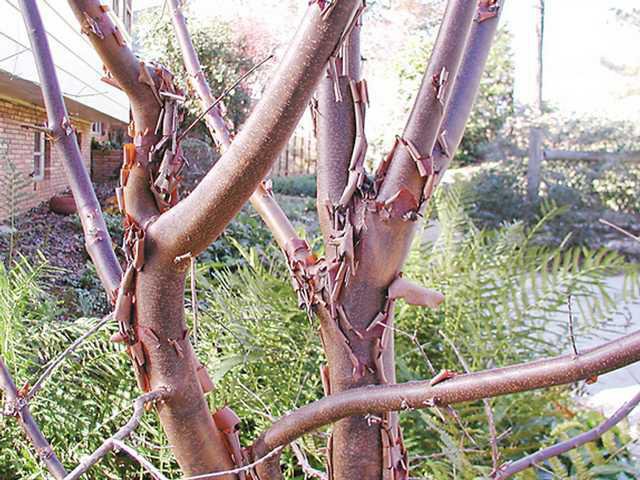Question: Can you recommend a small to medium size tree that has good fall color and a trunk and branches that look good in the winter landscape?
Answer: We gardeners are always looking for plants that provide interest during the fall and winter, when the more interesting features of most plants are either declining or dormant. One interesting tree that you might consider is the paperbark maple (Acer griseum).
This is a slow growing tree that grows to 25 feet or so in height and about half as wide. Let me say up front that this is not a particularly drought-tolerant tree, but I believe that most average gardens have some locations where this will not be a problem.
The paperbark maple has brilliant red fall color, except on those infrequent occasions when an early frost occurs. Its bare trunk and branches make a striking sight with cinnamon-colored bark peeling away in paper-thin sheets from a smooth trunk.
The leaves of the paperbark, which are late coming out in the spring, are dark green above and silvery below. The inconspicuous red flowers develop into attractive winged seeds.
Choose a site for this tree that is partially shaded and likely to retain ground moisture. A site near a downspout from your roof may be ideal, but avoid planting the tree too close to your house or another building.
Another thing to be mindful of with any tree that is supposed to be small to moderate in size is a soil that is overly rich in nutrients. This may result in a much faster growth rate and larger mature size than you expect. I am a great believer in soil amendments, but the old saying "moderation in all things" is applicable here.
Q: It seems our winter temperatures go from one extreme to another. Are such extremes harmful to most landscape plants?
A: Normal cold weather is not harmful to plants adapted to our climate, and many need minimal periods of cold weather to perform their best. But swings from near record highs to near record lows may be another matter. The following tips may help prepare plants for extremes.
When buying plants, especially mail-order ones, make sure they are advertised to grow in your USDA plant hardiness zone. If you want to experiment with plants of marginal hardiness, plant them in sheltered areas or be prepared to bring them indoors for the winter.
Learn to recognize the microclimates in your landscape. Large areas of open ground exposed to wind on all sides, and low, shaded areas enclosed by shrubbery or structures will be most affected by extreme cold.
Refrain from fertilizing plants in late summer or fall to prevent tender new growth that will not have time to acclimate to winter. Wait for full dormancy before pruning woody plants.
Early-blooming plants such as winter daphne (Daphne odora) and Camellia can be discouraged from blooming too early by locating them with a north exposure and/or in shaded areas.
Soil organic matter and a few inches of mulch help retain moisture, which in turn helps to moderate the effect of air temperature extremes on soil temperature. Dry soil conditions going into winter make bulbs and other dormant perennials more likely to emerge ahead of schedule.
Planting bulbs too shallow makes them more susceptible to early emergence in response to winter warm spells. Plant most bulbs at a depth that is two and a half to three times their width.
Russ England is a Master Gardener trained and certified in horticulture and related areas through by the Georgia Cooperative Extension Service.

